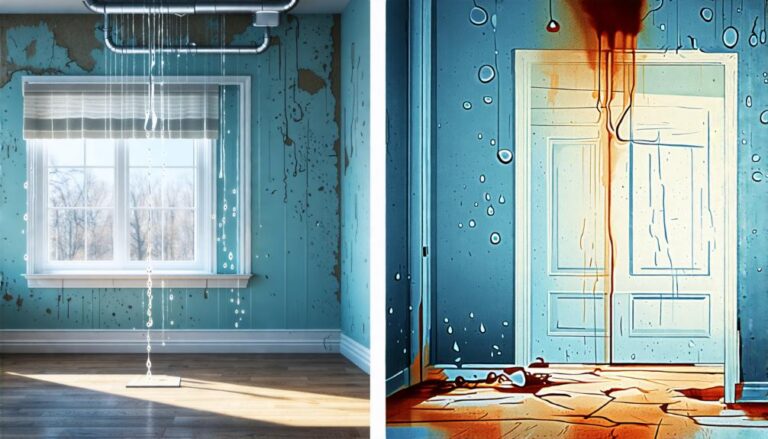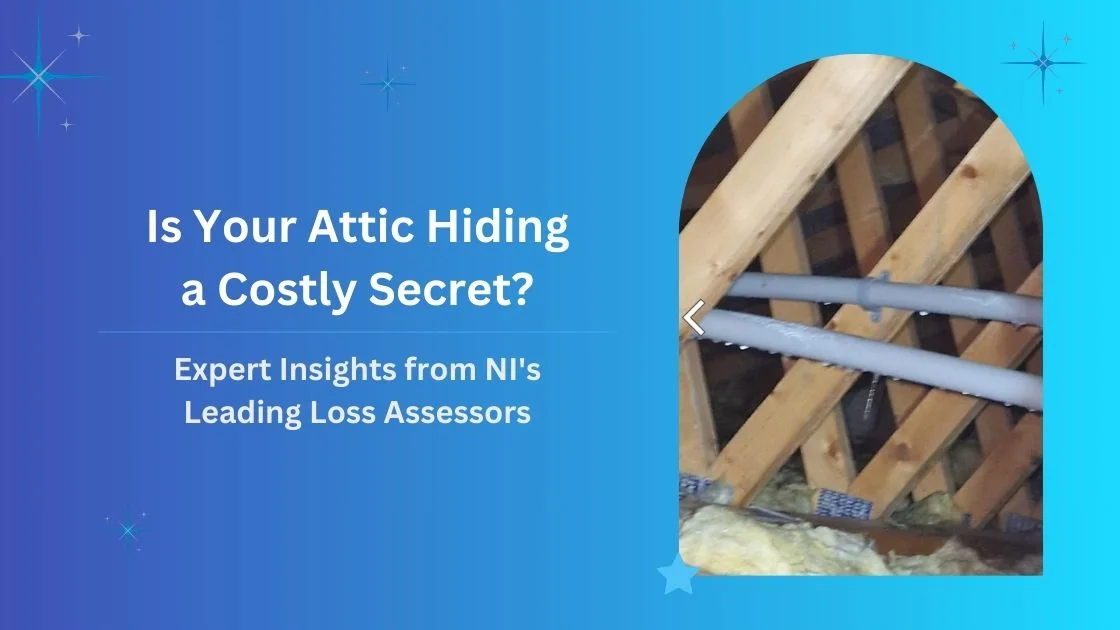Water leaks can cause significant damage to both residential and commercial properties, making early detection essential. In this article, we’ll explore common signs of water leaks in residential and commercial properties, helping you decide if you need a professional leak detection service.
Common signs of water leaks in homes include unexpected increases in water bills, the sound of running water when taps are off, water stains or discolouration, musty odours or mould growth, and warped or buckled flooring.
In commercial buildings, pipe leaks, roof leaks, and hidden water leaks are common, often signalled by unusual noises, water discolouration, or changes in water pressure.
Recognising these signs is key to preventing costly repairs. By understanding the causes and solutions you can mitigate the impact of water damage in your property.
Key Takeaways
- Unexpected increases in water bills can indicate hidden leaks in both residential and commercial properties.
- Sounds of running or dripping water when taps are off can signal a leak in any type of property.
- Visible signs of water damage, such as stains or discolouration on walls and ceilings, suggest leaks in residential and commercial buildings.
- Musty odours or mould growth due to excess moisture can be signs of water leaks in various types of properties.
What are the 5 signs you have a water leak in your home?
Identifying whether a water leak exists in your home can be done by recognising one or more of the following five indicative signs. As a homeowner, being aware of these signs can help you address potential issues promptly, preventing further damage and fostering a sense of security and belonging in your living space.
- An unexpected increase in your water bill may indicate a hidden leak.
- If you hear the sound of running water, even when all taps are turned off, can be a clear indication of a leak.
- The presence of water stains or discolouration on walls and ceilings can be a sign of a leaky pipe.
- Musty odours or mould growth can result from excessive moisture due to a leak.
- Warped or buckled flooring can also signal a water leak.
If you suspect a leak in your home, you should contact a leak detection specialist near you.
What are the common types of water leaks in commercial buildings?
Commercial buildings are susceptible to various types of water leaks, ranging from minor issues with dripping taps to more extensive problems with leaking roofs and faulty plumbing systems. These leaks can cause significant damage, disrupt business operations, and lead to costly repairs if left undetected.
Common types of water leaks in commercial buildings include pipe leaks, roof leaks, and hidden water leaks behind walls or under floors.
Identifying signs of a water leak is vital to prevent extensive water damage. Property managers and owners should be aware of unusual noises, water discolouration, and unexplained changes in water pressure. Using smart water technologies and water leak detection equipment can also aid in early detection.
To prevent water leaks, regular maintenance of plumbing systems, inspection of roofs, and replacement of old pipes are important. By taking proactive measures, commercial building owners can prevent leaks, minimise losses, and guarantee a safe and secure environment for occupants.
Regular inspections and maintenance can help prevent water leaks, protecting the property and its occupants from the devastating effects of extensive water damage.
How to detect a hidden leak in commercial buildings?
Detecting hidden water leaks in commercial buildings necessitates a proactive approach to mitigate potential damage and costly repairs.
Using water leak sensors and leak detectors
Advanced water leak sensors and leak detectors can play a crucial role in identifying hidden leaks in commercial buildings by alerting facility managers to potential issues before they escalate into costly problems.
These devices are designed to detect even small leaks in water supply pipes, underground leaks, and other common sources of water leaks, providing an early warning system that allows for prompt action to be taken.
When a leak is detected, the sensor or detector sends an alert to the facility manager or maintenance team, enabling them to quickly locate and repair the issue.
Monitoring for obvious signs such as warping or bubbling
Visual inspections can be an effective way to identify hidden water leaks in buildings, particularly by monitoring for obvious signs such as warping or bubbling of walls, floors, and ceilings. These signs can indicate a hidden leak, which can lead to costly water damage restoration if left undetected.
| Signs of Water Leaks | What to Look For |
|---|---|
| Warping or Bubbling | Walls, floors, and ceilings that are warped or bubbled, indicating water damage |
| Water Stains | Yellow or brown stains on walls, floors, and ceilings, indicating water leakage |
| Mould Growth | Visible mould or mildew growth on walls, floors, and ceilings, indicating excessive moisture |
| Dripping Water | Visible signs of dripping water, such as water droplets on surfaces or water pooling on floors |
| High Water Bill | Unexplained increases in water bills, indicating a possible hidden leak |
What steps can you take to prevent water damage from leaks?
Several proactive measures can be taken to minimise the risk of water damage from leaks, starting with regular inspections of plumbing systems and appliances.
To prevent water damage, it is essential to identify signs of a hidden water leak in your home or commercial property. Look for common sources such as plumbing leaks, malfunctioning water heaters, and worn-out washing machines. These can lead to costly repairs if left undetected.
To detect leaks early, consider installing leak-detecting devices or smart sensors that alert you to potential issues. Inspect your property regularly for signs of water damage, such as warping, bubbling, or discolouration.
Protect your property by addressing any issues promptly and taking preventative measures, such as replacing old appliances and pipes.
Frequently Asked Questions
How Long Does It Take for a Water Leak to Cause Significant Damage?
The time it takes for a water leak to cause significant damage varies, but generally, within 24-48 hours, notable deterioration can occur, with more severe destruction unfolding over several days or weeks, depending on the severity and location of the leak.
Can a Water Leak Lead to Mould and Mildew Growth?
Yes, water leaks can lead to mould and mildew growth, threatening occupant health and structural integrity. For example, a commercial office building in Belfast experienced widespread mould infestation due to an undetected roof leak, forcing the firm to temporarily relocate.
Are Water Leaks Typically Covered by Homeowners or Business Insurance?
Typically, homeowners and business insurance policies cover water leaks caused by sudden, accidental events, such as burst pipes. However, damage resulting from gradual leaks, wear and tear, or poor maintenance may be excluded from cover.
What Is the Average Cost of Repairing a Water Leak in a Home?
The cost of repairs can easily spiral out of control if the leak is not fixed. But you should be able to reclaim the cost through your insurance. Give PCLA a call today to find out more.
Can I Fix a Water Leak Myself or Should I Hire a Professional?
While minor leaks may be DIY-fixable, it is often recommended to hire a professional to ensure accurate detection and repair, especially for complex or hidden leaks, to prevent further damage and costly consequences.
Conclusion
Unnoticed water leaks are a ticking time bomb, silently wreaking havoc on properties.
Picture the dramatic irony: a proprietor diligently water-proofing their accounts, oblivious to the dripping tap in the background.
Both commercial and residential buildings are vulnerable to concealed water leaks.
Swift detection and prevention measures can avert catastrophic damage.
Leaks often disguise themselves as minor issues, but with vigilance, one can stem the tide of destruction.
Regular inspections and preventative measures are key to avoiding financial and structural devastation.



